Need a densely growing ground cover for a shady spot? Foamflower (
Tiarella cordifolia) fits the bill and then some. The foliage of this Mid-Atlantic native plant is evergreen, except in very cold winters, and the white, midspring blooms brighten a shady area. There are a variety of cultivars with different leaf shades and coloration. Since Tiarellas are resistant to browsing by deer and rabbits, their foliage persists throughout the seasons.
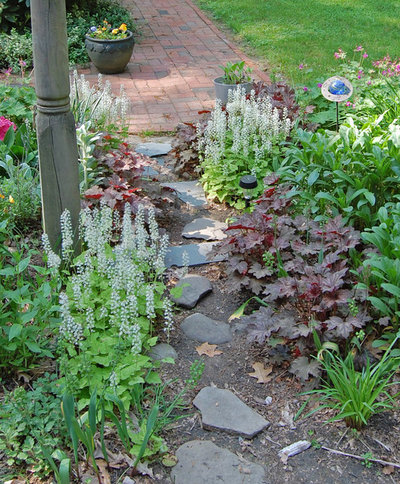 Botanical name: Tiarella cordifoliaCommon names:
Botanical name: Tiarella cordifoliaCommon names: Foamflower, heartleaf foamflower, false miterwort
Origin: New Brunswick in Canada, south to Georgia and west to Michigan
Where it will grow: Hardy to -30 degrees Fahrenheit (USDA zones 4 to 9; find your zone)
Water requirement: Medium to moist soil
Light requirement: Partial to full shade
Mature size: 8 to 15 inches tall and 12 to 24 inches wide; some selections are more aggressive spreaders
Benefits and tolerances: Semievergreen to evergreen in mild winters; an excellent ground cover; deer and rabbit resistant; few insect pests, though sometimes attacked by black vine weevils
Seasonal interest: White to pink flowers in midspring, some with interesting foliage for nine to 12 months
When to plant: Potted nursery stock can be planted spring through fall as long as adequate moisture is available; fresh seed is best planted immediately or kept cool and moist for fall planting.
Shown: Tiarella cordifolia ‘Running Tapestry’ lining a path with
Heuchera ‘Montrose Ruby’
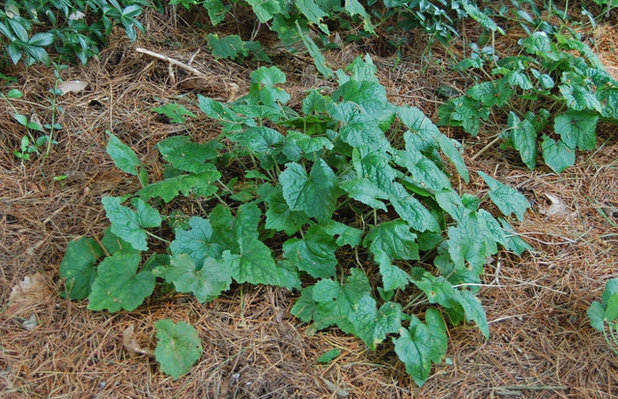 Distinguishing traits.
Distinguishing traits. Plants grow in mounds of maple-shaped leaves with three to five lobes. The leaves are deeply veined, giving them a coarse texture. There are two varieties of the species: one is clump forming (var.
collina), often labeled
Tiarella wherryi;
the other, running foamflower (var.
cordifolia), is a more aggressive spreader, sending out stolons to start new plants.
Shown: A running foamflower in open shade under pines and eastern redcedar on my property. My goal here is to replace the nonnative Vinca with a mosaic of foamflowers and heucheras.
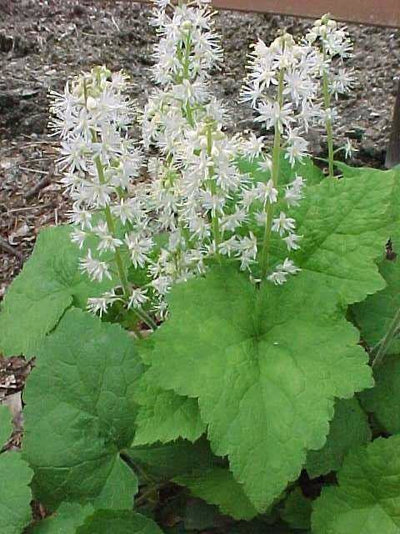
Missouri Botanical Garden
In the spring foamflower sends up spikes of white to pinkish flowers. The stamens stick out beyond the petals, adding to the airiness of the blooms — like foam.
Shown: Tiarella ‘Oakleaf’, one of the clumping cultivars
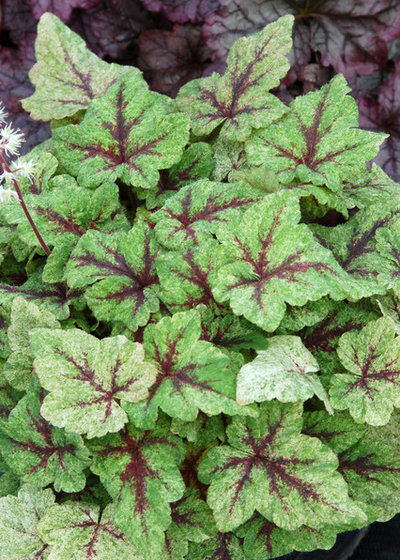
Terra Nova® Nurseries, Inc
Some cultivars of Tiarella
are selected or bred for the deep coloration along the veins, as seen on this ‘Mystic Mist’ foamflower. Much like the colorful heucheras, this particular cultivar, developed by Terra Nova Nurseries, is the result of an extensive breeding program that includes both native and nonnative species and other hybrids.
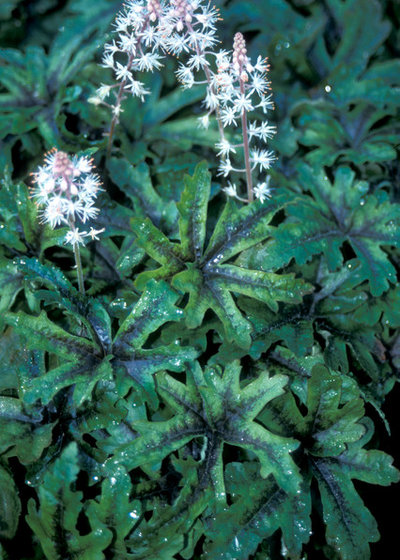
Terra Nova® Nurseries, Inc
There are also selections with deeply lobed leaves. Some of these are hybrids with a species from the Pacific Northwest,
Tiarella trifoliata. Tiarella ‘Iron Butterfly’ is shown here.
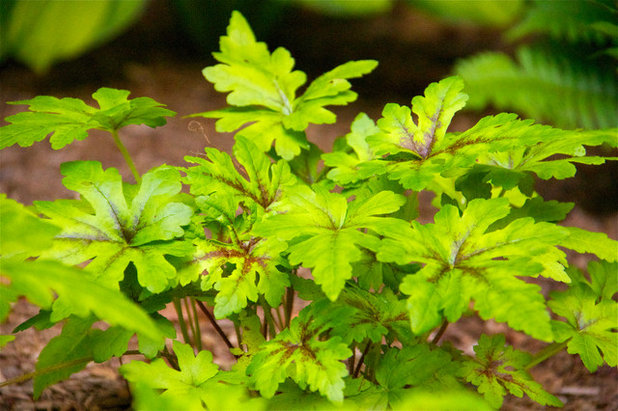
Bloom Landscape Design and Fine Gardening Service
This
Tiarella rivals some of the chartreuse-colored heucheras, to which Tiarellas are close botanical relatives.
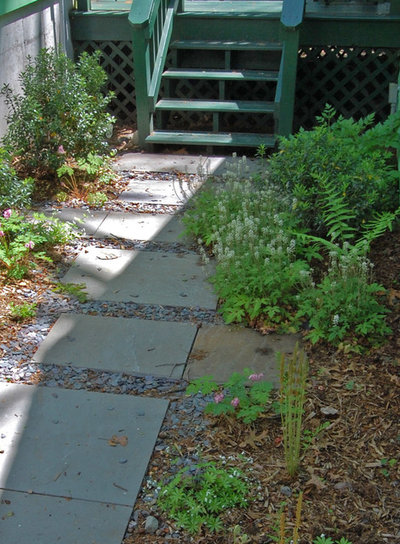 How to use it.
How to use it. Here is a walkway planted with other shade-tolerant plants, including cinnamon fern (
Osmundastrum cinnamomeum), wild bleeding heart (
Dicentra eximia), sweet woodruff (
Galium odoratum) and inkberry holly (
Ilex glabra ‘Shamrock’).
At the end of winter, the foliage will look rather worn out and tired. The foliage is still providing energy to the plant, so it’s best to leave it in place for stronger blooms come spring.
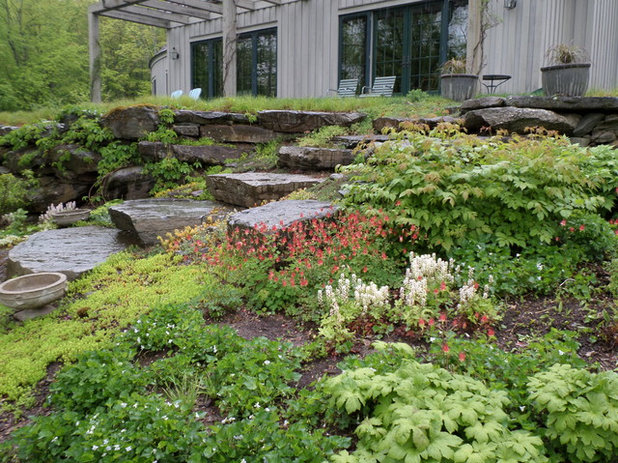
Zone4 Landscapes Ltd.
Here’s a woodland composition with Tiarella, viola, goldenseal, columbine and sedum. After these finish flowering in the spring, there will still be a great variety of foliage texture to maintain interest. Other woodland species that could work well with Tiarella include Solomon’s seal, green and gold (
Chrysogonum sp) and creeping phlox.
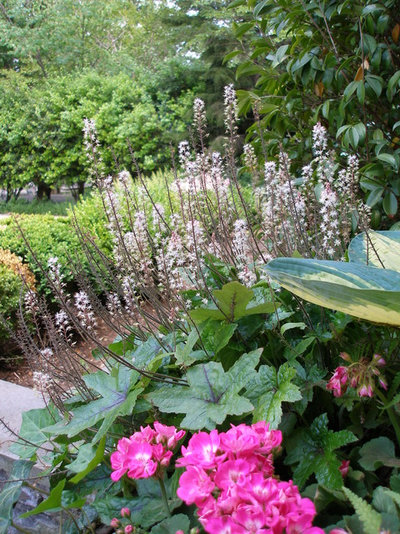
Wheat's Landscape
Tiarellas also grow well in pots. The clumping forms with colorful leaves work well as fillers; just remember to maintain soil moisture to keep the foliage looking good.
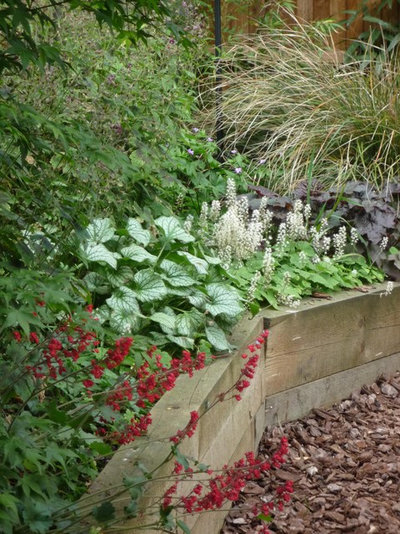
Fenton Roberts Garden Design
Here’s another mixed composition of foamflower with
Brunnera macrophylla ‘Jack Frost’ and dark-leaved heuchera.
Tiarellas are available from many garden centers as well as online and at native-plant nurseries. When selecting a particular variety, consider not only the appearance of the foliage but also the growth habit. Is it a runner or a clumper? Some examples of runners:
Tiarella cordifolia var.
cordifolia, the cultivars ‘Running Tapestry’ and ‘Dark Eyes’. There are more choices in clumpers: ‘Brandywine’, ‘Elizabeth Oliver’, ‘Spring Symphony’ and
Tiarella cordifolia var.
collina (or
T. wherryi).
Planting notes. Tiarellas grow best in rich, moist but well-drained soils, but they are tolerant of poorer soils, as seen here with the ‘Dark Star’ foamflowers growing in sandy soil that gets a lot of moisture.
They do well in partial to full shade; open or dappled shade works well. Foamflowers can grow in sunnier locations, but they need more moisture there to keep the leaves from burning. Conversely, they can handle some dryness in more shade.
More:Houzz guides to gardening with native plants
Set Your Shade Garden Aglow With Light





